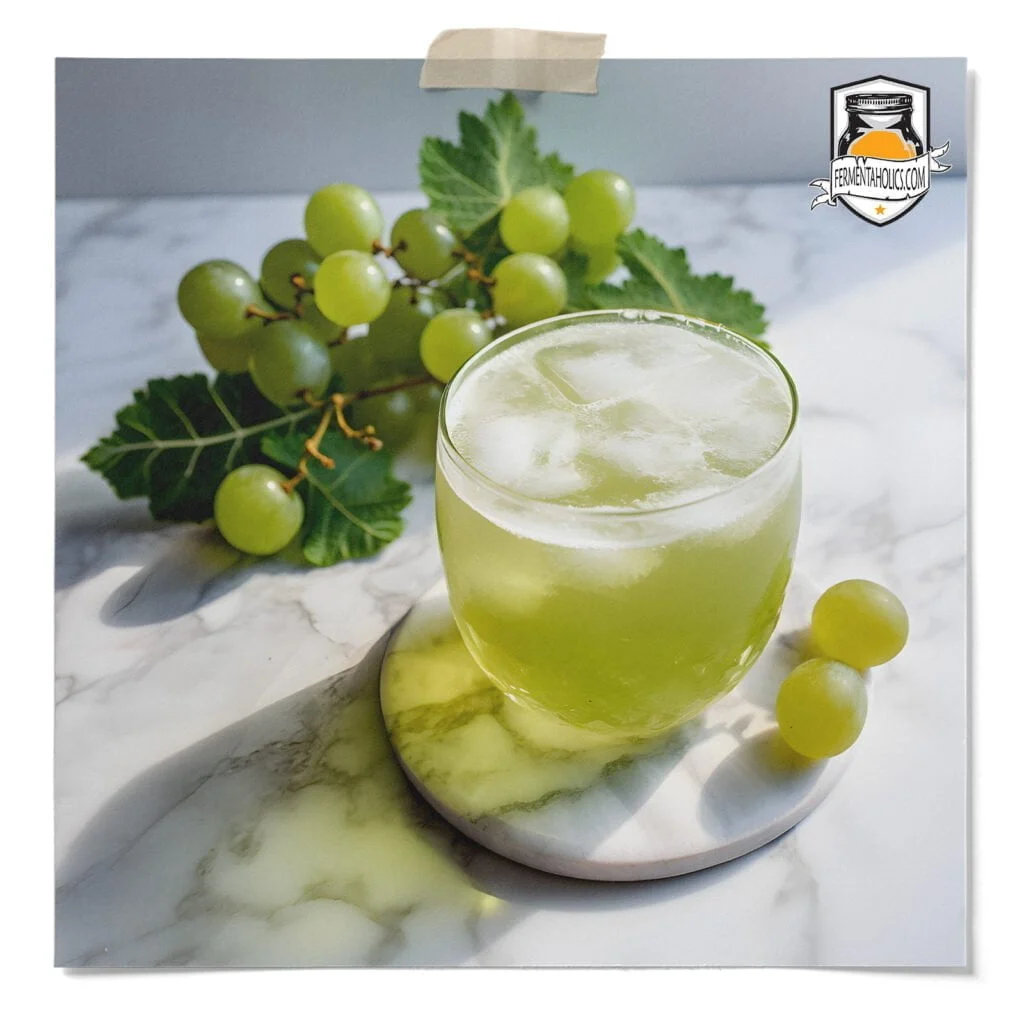
This recipe is simple and grape. I mean, great! 😀 If you are trying to convince someone to like kombucha or are trying to get your kids to drink kombucha, this is the recipe for you. The flavor is subtle, mild, and familiar. The color is will be slightly different than the kombucha you start with. I typically use a mix of green and black tea, which comes out slightly golden. The grapes add a haziness to the kombucha, cloudy enough to where it is no longer see-through, with a nice body to it. When you smell it, you get soft, fruity notes with hints of champagne but not overly pungent. The first taste doesn’t overwhelm the taste buds. The thick body provides a silkiness that allows the flavors to linger pleasingly. The grapes somehow subtly and bluntly take over the flavor of the kombucha. You get a gentle and subtle flavor–but it tastes just like grapes. Anything sour goes well with kombucha, so using green grapes a perfect match. They aren’t overly sour as to deter those who aren’t into serious face puckering sourness but are enough to keep it interesting. Grapes are cheap, readily available, and are high in vitamin K.
It’s important to note that making homemade kombucha is almost always a two-step fermentation process. Brewing kombucha is only a one-step process for those who prefer an unflavored flat kombucha. Otherwise, the steps consist of a primary fermentation and a secondary fermentation.
Primary fermentation is the first step of the kombucha brewing process. This is where your SCOBY transforms regular sweet tea into the tart and slightly sweet kombucha we love. At the end of this stage, you will have finished kombucha, but it will be flat and unflavored. Have you skipped this step? Then check out our guide on how to make kombucha at home, and for jun kombucha, see our post on how to make jun kombucha tea at home. Traditional kombucha is going to yield a bolder brew, while jun kombucha is milder and can be a bit tarter.
Secondary fermentation is the step where you bottle, carbonate, and flavor your kombucha with the addition of sugar and flavors. In this step, the finished kombucha from the primary is mixed with sugar, fruits, or other flavors before bottling it with specialized lids that can hold pressure, like flip-top bottles. The bottled kombucha is then left at room temperature for natural fermentation, where yeast carbonates the kombucha within the sealed bottle. The ideal temperature range for this process is between 75-85°F. The amount of time needed to carbonate within the bottle is highly tied to temperature, which can take anywhere from 2-10 days.
💡Since this recipe is for the secondary fermentation, to make this recipe, you’ll need to have kombucha that has finished the primary fermentation and is ready to bottle.
This recipe makes one 16-fluid-ounce bottle. A 1-gallon batch of kombucha will make seven 16-ounce bottles, so for one gallon, you will need to multiply the ingredients by 7. Before beginning this recipe, you will need to:
30
30 Green Grapes
1 gallon Fermented Kombucha (reserve 2 or more cups as the starter for your next batch)
6-7 16 OZ Flip top bottles
1 Small strainer
Puree grapes in a blender. If you don’t want to puree them, you can dice them up then plop the pieces into the bottles (this is cleaner, but you may get less flavor).
If you puree, use a funnel to pour the mixture into the bottles.
Fill each bottle with kombucha, leaving about an inch of headspace.
Be sure to leave yourself enough kombucha to use as your starter for the next batch, about 2 cups per gallon.
Tightly place caps on each bottle.
Keep bottles at room temperature for 2-10 days, depending on the temperature of your room! The closer you get to 80F, the better results you’ll have.
Once per day, you’ll want to “burp” the bottles by removing the cap to allow built-up pressure to escape and place the cap back on. As soon as you put the cap back on, the carbonation will begin to build back up, so don’t worry about it getting flat. Try not to skip this or you will have kombucha all over your face and your kitchen when you do go to open it**If you choose to puree the grapes, invert the bottles to incorporate the grape puree BEFORE you burp the bottles. If you skip this, the puree may shoot out at you and is not very pretty.
When you are happy with the flavor and fizziness of your kombucha (2-10days), place bottles in the fridge to chill and halt the fermentation.
